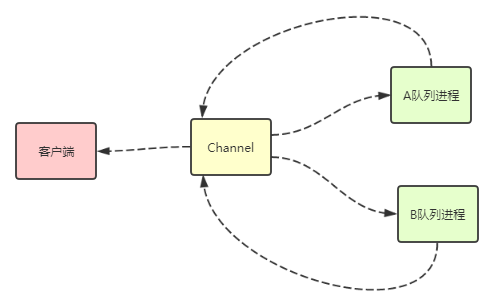确认机制
在以前章节中,我们说到过写消息的时候 数据是先到 reader 进程再到channel 进程再,再由channel进程分发给队列进程。
==rabbitmq 本身提供了confirm机制,但rabbitmq服务端在什么时候返回confirm信息给客户端呢?==
有以下几种可能.
- channel进程一拿到消息后就返回confirm给客户端,那这样不就会丢消息?
- 队列进程一拿到消息就返回给客户端,那路由到多个队列的时候 怎么办呢?
- 队列写到了磁盘的时候再返回给客户端?
从源码来分析流程
1. channel通道拿到消息之后,去mnesia 数据库通过exchange和routingkey 找到所绑定的队列的qids。然后通过 delegate:cast 下发消息给队列进程
deliver_to_queues({Delivery = #delivery{message = Message = #basic_message{
exchange_name = XName},
mandatory = Mandatory,
confirm = Confirm,
msg_seq_no = MsgSeqNo},
DelQNames}, State = #ch{queue_names = QNames,
queue_monitors = QMons}) ->
Qs = rabbit_amqqueue:lookup(DelQNames),
DeliveredQPids = rabbit_amqqueue:deliver(Qs, Delivery),
%% The pmon:monitor_all/2 monitors all queues to which we
%% delivered. But we want to monitor even queues we didn't deliver
%% to, since we need their 'DOWN' messages to clean
%% queue_names. So we also need to monitor each QPid from
%% queues. But that only gets the masters (which is fine for
%% cleaning queue_names), so we need the union of both.
%%
%% ...and we need to add even non-delivered queues to queue_names
%% since alternative algorithms to update queue_names less
%% frequently would in fact be more expensive in the common case.
{QNames1, QMons1} =
lists:foldl(fun (#amqqueue{pid = QPid, name = QName},
{QNames0, QMons0}) ->
{case dict:is_key(QPid, QNames0) of
true -> QNames0;
false -> dict:store(QPid, QName, QNames0)
end, pmon:monitor(QPid, QMons0)}
end, {QNames, pmon:monitor_all(DeliveredQPids, QMons)}, Qs),
State1 = State#ch{queue_names = QNames1,
queue_monitors = QMons1},
%% NB: the order here is important since basic.returns must be
%% sent before confirms.
State2 = process_routing_mandatory(Mandatory, DeliveredQPids, MsgSeqNo,
Message, State1),
State3 = process_routing_confirm( Confirm, DeliveredQPids, MsgSeqNo,
XName, State2),
?INCR_STATS([{exchange_stats, XName, 1} |
[{queue_exchange_stats, {QName, XName}, 1} ||
QPid <- DeliveredQPids,
{ok, QName} <- [dict:find(QPid, QNames1)]]],
publish, State3),
State3.
2. 如果上面没有找到绑定的队列,则会进行返回没有找到队列的信息给客户端。
所以 客户端 mandatory = true 的时候,是在channel层来决定是否返回有没找到路由信息的。如果找到了,并不会返回任何信息。
process_routing_mandatory(false, _, _MsgSeqNo, _Msg, State) ->
State;
process_routing_mandatory(true, [], _MsgSeqNo, Msg, State) ->
ok = basic_return(Msg, State, no_route),
State;
process_routing_mandatory(true, QPids, MsgSeqNo, Msg, State) ->
State#ch{mandatory = dtree:insert(MsgSeqNo, QPids, Msg,
State#ch.mandatory)}.
3. Channel进程判断一下是否要返回confirm信息给客户端
备:rabbit_log:print 为个人添加的打印日志的函数,以下类同
process_routing_confirm(false, _, _MsgSeqNo, _XName, State) ->
State;
process_routing_confirm(true, [], MsgSeqNo, XName, State) ->
rabbit_log:print("channel process_routing_confirm confirm true MsgSeqNo:~p ~n",[MsgSeqNo]),
record_confirms([{MsgSeqNo, XName}], State);
process_routing_confirm(true, QPids, MsgSeqNo, XName, State) ->
rabbit_log:print("channel process_routing_confirm confirm true QPids:~p MsgSeqNo:~p ~n",[QPids,MsgSeqNo]),
State1 = State#ch{unconfirmed = dtree:insert(MsgSeqNo, QPids, XName,
State#ch.unconfirmed)},
rabbit_log:print("channel process_routing_confirm confirm confirmed:~p, unconfirmed:~p ~n",[State1#ch.confirmed,State1#ch.unconfirmed]),
State1.
==如果客户端设置了需要confirm信息,并且找到了队列的情况下,则将当前消息的编号(记住这只是编号,相对于每个channel来说每条消息都会自动+1)及队列进程PID 进行保存在unconfirm变量中。==
反之没有找到队列进程则直接就返回confirm消息给客户端。
4. 队列进程拿到消息
deliver_or_enqueue(Delivery = #delivery{message = Message,
sender = SenderPid,
flow = Flow},
Delivered, State = #q{backing_queue = BQ,
backing_queue_state = BQS}) ->
send_mandatory(Delivery), %% must do this before confirms
{Confirm, State1} = send_or_record_confirm(Delivery, State),
Props = message_properties(Message, Confirm, State1),
{IsDuplicate, BQS1} = BQ:is_duplicate(Message, BQS),
State2 = State1#q{backing_queue_state = BQS1},
5. 队列进程首先判断是否要立刻返回消息给channel 进程
send_or_record_confirm(#delivery{confirm = false}, State) ->
{never, State};
send_or_record_confirm(#delivery{confirm = true,
sender = SenderPid,
msg_seq_no = MsgSeqNo,
message = #basic_message {
is_persistent = true,
id = MsgId}},
State = #q{q = #amqqueue{durable = true},
msg_id_to_channel = MTC}) ->
MTC1 = gb_trees:insert(MsgId, {SenderPid, MsgSeqNo}, MTC),
{eventually, State#q{msg_id_to_channel = MTC1}};
send_or_record_confirm(#delivery{confirm = true,
sender = SenderPid,
msg_seq_no = MsgSeqNo}, State) ->
rabbit_misc:confirm_to_sender(SenderPid, [MsgSeqNo]),
{immediately, State}.
==假如消息为持久化数据,则将消息编号及Channel的PID保存到 msg_id_to_channel 变量中,待后面使用==
==否则直接返回给channel进程==
返回channel 进程的消息函数代码如下:
gen_server2:cast(Pid, {confirm, MsgSeqNos, self()}).
6. 队列进程消息分配给在线的消费或者写入到磁盘
这个过程请参数 写入过程-概要 及 写入过程-索引持久化
7. 队列进程返回确认信息给Channel进程
在执行完了 deliver_to_queues 过程之后,立即执行 noreply 函数,这个函数里会再次执行 next_state函数,在next_state 函数里再次执行 ==confirm_messages 函数函,将 上面保存的 msg_id_to_channel 变量里的数据,清除掉并且返回给Channel进程confirm消息==
confirm_messages([], MTC) ->
MTC;
confirm_messages(MsgIds, MTC) ->
{CMs, MTC1} =
lists:foldl(
fun(MsgId, {CMs, MTC0}) ->
case gb_trees:lookup(MsgId, MTC0) of
{value, {SenderPid, MsgSeqNo}} ->
{rabbit_misc:gb_trees_cons(SenderPid,
MsgSeqNo, CMs),
gb_trees:delete(MsgId, MTC0)};
none ->
{CMs, MTC0}
end
end, {gb_trees:empty(), MTC}, MsgIds),
rabbit_misc:gb_trees_foreach(fun rabbit_misc:confirm_to_sender/2, CMs),
MTC1.
confirm_to_sender(Pid, MsgSeqNos) ->
gen_server2:cast(Pid, {confirm, MsgSeqNos, self()}).
8. Channel 通道进程接收到队列进程返回的confirm指令,再返回给confirm消息给客户端
handle_cast({confirm, MsgSeqNos, QPid}, State = #ch{unconfirmed = UC}) ->
rabbit_log:print("channel handle_cast confirm MsgSeqNos:~p , confirm:~p unconfirmed:~p ~n",[MsgSeqNos,State#ch.confirmed,UC]),
{MXs, UC1} = dtree:take(MsgSeqNos, QPid, UC),
%% NB: don't call noreply/1 since we don't want to send confirms.
rabbit_log:print("channel handle_cast confirm record_confirms start ~p ~n",[?MODULE]),
Data = record_confirms(MXs, State#ch{unconfirmed = UC1}),
rabbit_log:print("channel handle_cast confirm record_confirms over ~p ~n",[?MODULE]),
noreply_coalesce(Data).
==Channel 接收到指令,则从 unconfirmed 中删除掉相关队列进程与当前消息编号的关系,直接到这个消息所有进程都返回confirm消息了,再挪到 confirm 变量中去==
在这个回调方法里 返回 {noreply,State,Timeout} 数据格式,进行再次回调 noreply 方法 执行 next_state方法,再由next_state方法执行 send_confirms 方法将confirm变量中的消息进行返回confirm消息给客户端
noreply(NewState) ->
rabbit_log:print("channel noreply ~n"),
{noreply, next_state(NewState), hibernate}.
next_state(State) -> ensure_stats_timer(send_confirms(State)).
send_confirms(State = #ch{tx = none, confirmed = C}) ->
rabbit_log:print("channel send_confirms confirmed:~p unconfirmed:~p ~n",[C,State#ch.unconfirmed]),
case rabbit_node_monitor:pause_partition_guard() of
ok -> MsgSeqNos =
lists:foldl(
fun ({MsgSeqNo, XName}, MSNs) ->
?INCR_STATS([{exchange_stats, XName, 1}],
confirm, State),
[MsgSeqNo | MSNs]
end, [], lists:append(C)),
send_confirms(MsgSeqNos, State#ch{confirmed = []});
pausing -> State
end;
打印的执行的流水日志:
PID:<0.563.0> Time: 2019:3:4 19:14:2
------*process_frame ,Method:{'basic.publish',0,<<"amq.direct">>,
<<"testQueue">>,true,false} : NewAState: {method,
rabbit_framing_amqp_0_9_1}
PID:<0.572.0> Time: 2019:3:4 19:14:2
channel Method:{'basic.publish',0,<<"amq.direct">>,<<"testQueue">>,true,false}, Flow:flow Content:{content,
60,
none,
<<144,0,
10,116,
101,120,
116,47,
112,108,
97,105,
110,2>>,
rabbit_framing_amqp_0_9_1,
[<<1,1>>]}
PID:<0.572.0> Time: 2019:3:4 19:14:2
channel start deliver_to_queues QID:<0.572.0>
PID:<0.572.0> Time: 2019:3:4 19:14:2
channel process_routing_confirm confirm true QPids:[<0.259.0>] MsgSeqNo:1
PID:<0.572.0> Time: 2019:3:4 19:14:2
channel process_routing_confirm confirm confirmed:[], unconfirmed:{ {1,
{1,
{ {1,
{<0.259.0>,
nil,
nil}},
{resource,
<<"testvhost">>,
exchange,
<<"amq.direct">>}},
nil,nil}},
{1,
{<0.259.0>,
{1,
{1,nil,
nil}},
nil,
nil}}}
PID:<0.572.0> Time: 2019:3:4 19:14:2
channel over deliver_to_queues QID:<0.572.0>
PID:<0.572.0> Time: 2019:3:4 19:14:2
channel noreply
PID:<0.572.0> Time: 2019:3:4 19:14:2
channel handle_cast mandatory_received MsgSeqNos:1
PID:<0.572.0> Time: 2019:3:4 19:14:2
channel noreply_coalesce start
PID:<0.572.0> Time: 2019:3:4 19:14:2
channel noreply_coalesce over
PID:<0.572.0> Time: 2019:3:4 19:14:2
channel handle_cast confirm MsgSeqNos:[1] , confirm:[] unconfirmed:{ {1,
{1,
{ {1,
{<0.259.0>,
nil,
nil}},
{resource,
<<"testvhost">>,
exchange,
<<"amq.direct">>}},
nil,
nil}},
{1,
{<0.259.0>,
{1,
{1,nil,
nil}},
nil,
nil}}}
PID:<0.572.0> Time: 2019:3:4 19:14:2
channel handle_cast confirm record_confirms start rabbit_channel
PID:<0.572.0> Time: 2019:3:4 19:14:2
channel handle_cast confirm record_confirms over rabbit_channel
PID:<0.572.0> Time: 2019:3:4 19:14:2
channel noreply_coalesce start
PID:<0.572.0> Time: 2019:3:4 19:14:2
channel noreply_coalesce over
PID:<0.572.0> Time: 2019:3:4 19:14:2
channel noreply
PID:<0.572.0> Time: 2019:3:4 19:14:2
channel send_confirms confirmed:[[{1,
{resource,<<"testvhost">>,exchange,
<<"amq.direct">>}}]] unconfirmed:{ {0,
nil},
{0,
nil}}
整个流程图大概如下:

小结
RabbitMQ 客户端confirm机制的开启,如果消息是非持久化的情况下,数据到了队列进程就立马返回。
反之为持久化消息的情况下,是写到了磁盘(这是RabbitMQ官方的说法,其实这个地方并不能保存一定到了磁盘,只是保证到了linux内核,如果内核不宕机等情况下,是不会丢数据)中再返回成功。
但是如果提交的exchange及routingkey 没有匹配到队列也一样会返回confirm消息给客户端。
==所以如果一定要确保数据到达了队列,请开启 mandatory 机制。==
==mandatory 只有在没有找到队列的时候,会返回错误信息,否则不会返回。==